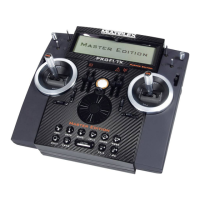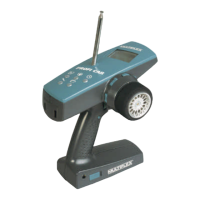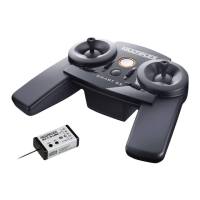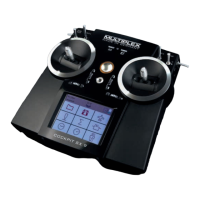UNIVERSAL Helicopter
- 6 -
For our example we have assumed the following ar-
rangement:
Servo: is:
1 DYN. THROTTLE
2 HEADMIX
3 HEADMIX
4 HEADMIX
5 SERVOMIX (free mixer)
Note that we are using a free mixer for servo 5. At
input 1 of this mixer we place the ready-made mixer
TAILSERVO. As we will see later, this slight extra
effort has definite benefits.
IMPORTANT!
The various curves associated with the
COLLECTIVE PITCH control do not appear at all
until you have assigned the servos.
• Assigning DYN.THROTTLE produces the throttle
curve.
• Assigning HEADMIX produces the collective
pitch curve and flare.
• Assigning TAILROTOR produces the curve for
the tail rotor.
If you have already looked around in the options for
the COLLECTIVE PITCH control, you will have seen
that these curves are not yet on offer.
If you have continued immediately after assigning the
transmitter controls, the screen should now show the
following menu:
I+i)
////////////////////
Y.\iiiiiiiiiiiiiiS
i\iiiiBYBJFKiiiii]
If you don’t see this menu, return to the operating
screen (press repeatedly) and then return to this
menu with the button sequence .
As we started from an empty memory, you will see
that servo 1 is still assigned to „UNUSED“ at this
stage.
You now have to carry out the following steps for each
of the servos in your model:
1. Press to open the „
Y.\
“ field (flashes)
2. Select the servo with the digi-adjustor
3. Press to open the „
\
“ field (flashes)
4. Select the function with the digi-adjustor
(DYN.THROTTLE, 3 X HEADMIX, SERVOMIX).
IMPORTANT!
By assigning the servos you have automatically
activated the mixers you require. If you want more
information about how mixers are constructed and
how they work, please turn to the section „This is how
it works ...“.
Once you have assigned all the servos press the
button once. This returns you to Menu 2 - assigning
and you can proceed directly to the menu for defining
the MIXERS. Press to do this.
Here you need to complete two tasks:
1. Change the name of the mixer to TAIL-MIX;
2. Assign the mixer inputs.
Both these steps are carried out in the same menu:
Let’s start with the name:
1. Press the button to open the name field
The first character in the name should now be
flashing.
Use the and buttons to select the character
in the name that you wish to change, and select
the characters with the digi-adjustor. For our ex-
ample we will assume the new mixer name to be
„
DIAQ/ZAU
“.
You can now assign the first mixer input.
2. Press and select TAIL ROTOR as the input.
I+i,'
[JFEW@i\DIAQ/ZAUii
ii*&\
-.iDIAQE@D@Eiiiiii]
When you have completed this step press the but-
ton once to return you to Menu 2 - Assignment. You
can now proceed directly to the menu for switching
flight modes by pressing .
4. Assigning switches
In our example we will start by setting up just two
switches.
Switch: selects:
S06 AUTO-ROTATION
S04 DIRECT THROTTLE
In the standard version of the transmitter these are the
two switches with long toggles to the immediate right
and left of the screen.
First a few words about this menu:
If you started from Step 3 - flight modes - the following
menu should now be on the screen:
[\iiiL#.,iiii
////////////////////
iDAZFiiiiiiJGADVN
-.(iiiiiii@Yii]
If not, return to the operating screen (press repeat-
edly) and then move to this menu again with the but-
ton sequence .
You cannot assign a switch at this point! If you
press the button the word „ON“ flashes, but you
cannot assign a switch to this flight mode. In fact,
flight mode 1 is always set to ON, but it has lowest
priority. You can therefore switch from flight mode 1 to
any other mode.
„So what do I have to do in this menu?“
You may well be wondering. We recommend that you
give the flight mode a name which is relevant to the
